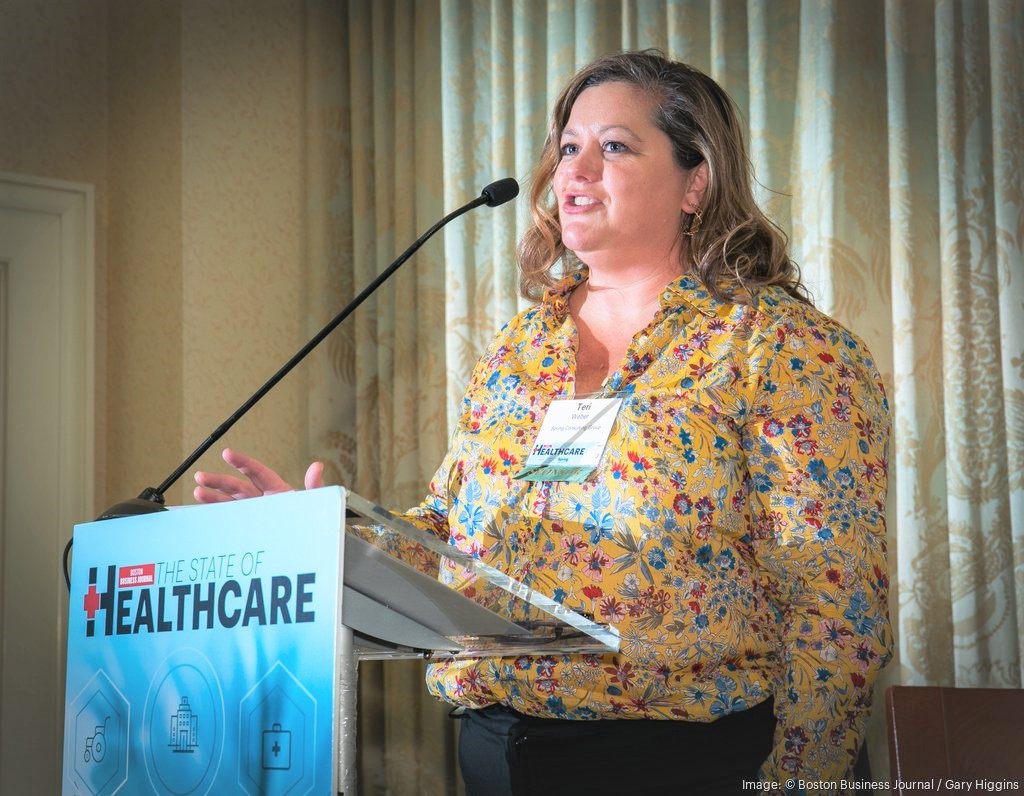This year we had the pleasure of spending Valentine’s Day with some of healthcare’s sharpest minds within the Boston area at the Boston Business Journal’s “State of Healthcare” luncheon. Spring was excited to sponsor the event again as we take pride in both our Boston roots and in our commitment to advancing innovation in healthcare. As attendees enjoyed a delicious lunch, an impressive panel took the stage to share their different viewpoints on healthcare: Anne Klibanski, MD, President and CEO of Mass General Brigham (the Brigham); Lora Pellegrini, Esq., President and CEO of the Massachusetts Association of Health Plans (MAHP); Kevin Tabb, MD, President and CEO of Beth Israel Lahey Health; and Greg Wilmot, President and CEO of the East Boston Neighborhood Health Center.
After every conference or event, I like to take the time to reflect. Here are my five key forces impacting healthcare today, in Boston and beyond.

1. Capacity
Anne kicked things off by addressing a crisis in national healthcare: capacity, meaning there is not enough room to take in the patients who need the kind of care in which Massachusetts prides itself. In fact, every day over 200 patients within the system sit in the emergency room or elsewhere because there is no bed for them. This type of emergency capacity used to happen once every few months, but it is now the daily norm.
The problem is obvious. What is not so obvious is the solution. However, Anne provided the following insight: access is capacity. So, when we think long-term, we need to focus on efficiency and access in order to solve for capacity issues. The discussion called to mind the following questions:
– Are community hospitals being fully leveraged for the kind of care they are best suited for?
– What kind of care can be delivered virtually, and are we maximizing those capabilities? A recent development here is virtual urgent care.
– How can we increase hospital at home usage? The fact is that people prefer this method, and it increases care while decreasing costs.
– How can we increase our ability to treat patients in an outpatient or ambulatory setting? Massachusetts is near the bottom in the country when you look at the number of outpatient sites available. We need more sites, closer to home, with a lower cost model, so that we can save beds at highly specialized facilities like the Brigham for patients who need them most.
2. Affordability
Lora joined the stage to help uncover the factors behind the longstanding issue of affordability. At MAHP, they are focused on trying to make healthcare both simpler and more affordable. In Massachusetts, Lora said, we have the best data in the country regarding the drivers of healthcare costs, and that data identifies the two top drivers as unit price and pharmaceutical costs. Lora stressed the importance of the pharmaceutical and life sciences companies taking responsibility and being a part of the conversation around healthcare costs. While health plans traditionally take very little margin, and instead make most of their money from investment income, pharma on the other hand is taking in approximately a 30% profit for drugs that are sometimes federally funded. In this regard, more transparency around pricing and accountability is needed. Additionally, Lora highlighted the following affordability factors:
– Technology can and should be leveraged for things like prior authorization and streamlined credentialing. “There should be no paperwork,” said Lora. While you might be surprised that telehealth is not its own item on this list, the panelists pointed out that it is critically intertwined with affordability. Kevin pointed out that the big costs in healthcare are not individual visit payments, but rather frequent trips to the ER and people becoming sicker because they didn’t get care sooner. By marrying this goal of moving more people to outpatient or community health centers when appropriate with the access benefits of telehealth, we can make a difference in costs.
– Healthcare costs are prohibiting employers from offering other innovative benefits to employees. How can employers find a balance? For self-insured employers, which Lora says make up about 60% of the MA market, there is more of an ability to customize programs and invest in wellness initiatives and other perks. On the flip side, for fully-insured employers, especially small businesses, this is harder to do. What we see sometimes is when costs are added due to new legislation or another development, employers start considering a self-insured model, but when more parties leave the merged market, the older and sicker populations are left behind.
– The Massachusetts Health Policy Commission (HPC) is doing great work, but Lora says they hold too little authority, something that needs to change.
To expand upon this topic, Greg pointed out that the key to the cost problem was to increase access and utilization of primary care and preventative medicine, stressing that by improving health outcomes upstream, we can mitigate the downstream impacts on the rest and more expensive aspects of our health system. Community health systems like the East Boston Neighborhood Health Center plays a big role here.
3. Workforce
Kevin brought us up to speed on the core challenges in healthcare related to workforce, a topic which he emphasized is a widespread issue across industries and geographies. In healthcare, though, he explained that it is the top issue keeping executives up at night and described it as an “acute on chronic crisis.” Importantly, Kevin noted that the workforce crisis didn’t come to fruition overnight, and we won’t get out of it overnight either. We were at the edge of a precipice, and the pandemic tipped us over. At Beth Israel Lahey Health, they are focused on competitiveness of job offers, adaptation of roles and flexibility, and partnering to train up both within the community and within their system.
As Greg noted, healthcare workers have “been running a marathon at a sprinter’s pace.” He is focused on rebuilding the workforce, one that is reflective of the populations they serve and emphasized the need to focus on the next generation of talent.
On the topic of workforce, Anne added that it’s not just about salary. At the Brigham they are rethinking how to create a safe and healthy work environment. We have seen a rise in workplace violence in healthcare and beyond, so how do we better protect our staff? “We are what we tolerate,” remarked Anne, so we need to make sure we’re not tolerating behaviors and practices – both from staff and from patients and other constituents – that we shouldn’t. This brings us to our next point.
4. Equity
As Anne pointed out, allowing gender-based or racist remarks, or violent behavior prohibits the development of a safe and inclusive workplace. Greg brought a unique viewpoint to the conversation as his community health center serves a very diverse population. Smaller clinics and health centers are often over-looked, but as Greg noted, one in five MA residents are receiving care at a community health center. He stressed the need for a two-prong approach:
- What happens in the exam room, which at community health centers is largely primary care and preventative medicine.
- What happens outside the exam room. Here Greg noted the importance of social determinants of health such as behavioral health, housing stability, food insecurity, education disparities, language barriers, and technology. How do we bring these issues into governmental policy? How do we invest in communities of color to address things head-on instead of waiting until they fester into bigger problems? How do we ensure equitable opportunities in the job market?
Greg argued that only by focusing on these two health components in tandem will we make any difference in health equity, and healthcare at large.
When it comes to telehealth, a digital divide still exists related to broadband, Wi-Fi, devices, medical literacy, and age (there is a large gap in senior utilization of telehealth). This needs to be part of the equity equation too. Do we need fancy technology? Or, as Kevin pointed out, “almost everyone has a phone.” Could a phone call suffice in some cases?
Lastly, all panelists agreed that COVID-19 highlighted the inequities that had been there all along, creating an urgency around equity that we very much needed.
5. Unity
Greg left us with a powerful, albeit brief poem by Muhammad Ali to ponder: “Me, We.” His point was that while we all have a personal responsibility for affecting change, we also can’t achieve that change on our own. It takes a “me” and it takes a “we.” The consensus was that each stakeholder has a role – providers, insurers, pharmaceutical companies, the government, and so on. When these cogs in the wheel operate in silos, the wheel does not turn.
Anne remarked that when the pandemic hit, it created a galvanizing force that brought all types of parties, including so-called competitors, together for the common good. Now, the impacts of COVID-19 have faded, but the panelists pondered why we can’t use our broken system as the next galvanizing force to bring everyone to the table. Numbers 1-4 on this list cannot be addressed without prioritizing number 5. This will require more active listening and compromise.
Overall, the Boston Business Journal’s State of Healthcare luncheon provided a thought-provoking and multifaceted conversation that gave me much to think about. But as we move toward what is hopefully a brighter future for healthcare, I will leave you with one final thought from Greg Wilmot:
“If we were to rewrite our [healthcare] system, would we design it the same way? We have been writing the same story and changing the last chapter and expecting a different outcome. That doesn’t work. We need to go back and start at the beginning, and rewrite chapters 1-10.”
Greg Wilmot



